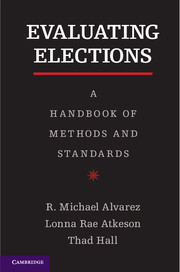Book contents
- Frontmatter
- Contents
- Acknowledgments
- Introduction
- 1 The Electoral Ecosystem
- 2 Easily Available Data for Performance Evaluation
- 3 Measuring the Experiences of Voters
- 4 Measuring the Performance of Poll Workers
- 5 Auditing the Election Ecosystem
- 6 Election Observation
- Conclusion
- Appendix: Precinct Opening, Closing, Election Day Forms
- References
- Index
Conclusion
Published online by Cambridge University Press: 05 December 2012
- Frontmatter
- Contents
- Acknowledgments
- Introduction
- 1 The Electoral Ecosystem
- 2 Easily Available Data for Performance Evaluation
- 3 Measuring the Experiences of Voters
- 4 Measuring the Performance of Poll Workers
- 5 Auditing the Election Ecosystem
- 6 Election Observation
- Conclusion
- Appendix: Precinct Opening, Closing, Election Day Forms
- References
- Index
Summary
It has been more than a decade since the events in the 2000 presidential election, especially in Florida, focused attention on voting technologies and election administration in the United States. During that time, researchers have made great strides working to understand what works, and what does not, in how elections are run in the United States and across the world. It is easy to forget that in the aftermath of the 2000 election, the book on election administration that was most current was a text written by Joseph Harris in 1934. Political scientists had clearly studied issues such as the effects of voter registration on turnout and residual votes (ballot roll-off in down ballot races), but the idea of studying elections for the purpose of improving the mechanics of our democracy and improving administration and implementation was not something on which many people were focused.
Over the past decade, researchers have generated many reports, articles, and books on election administration and voting technology. However, although much of this research has been quite valuable, it has not been accompanied by the development of a set of tools that can easily be applied to evaluate the performance of or effectiveness of election administration, either in a particular area (e.g., voter registration) or across the entirety of an election. This book has discussed a variety of evaluative tools, applied them to different electoral contexts, and discussed different examples of how these tools can be used to effectively gauge whether elections are well run in a particular place.
- Type
- Chapter
- Information
- Evaluating ElectionsA Handbook of Methods and Standards, pp. 146 - 150Publisher: Cambridge University PressPrint publication year: 2012

